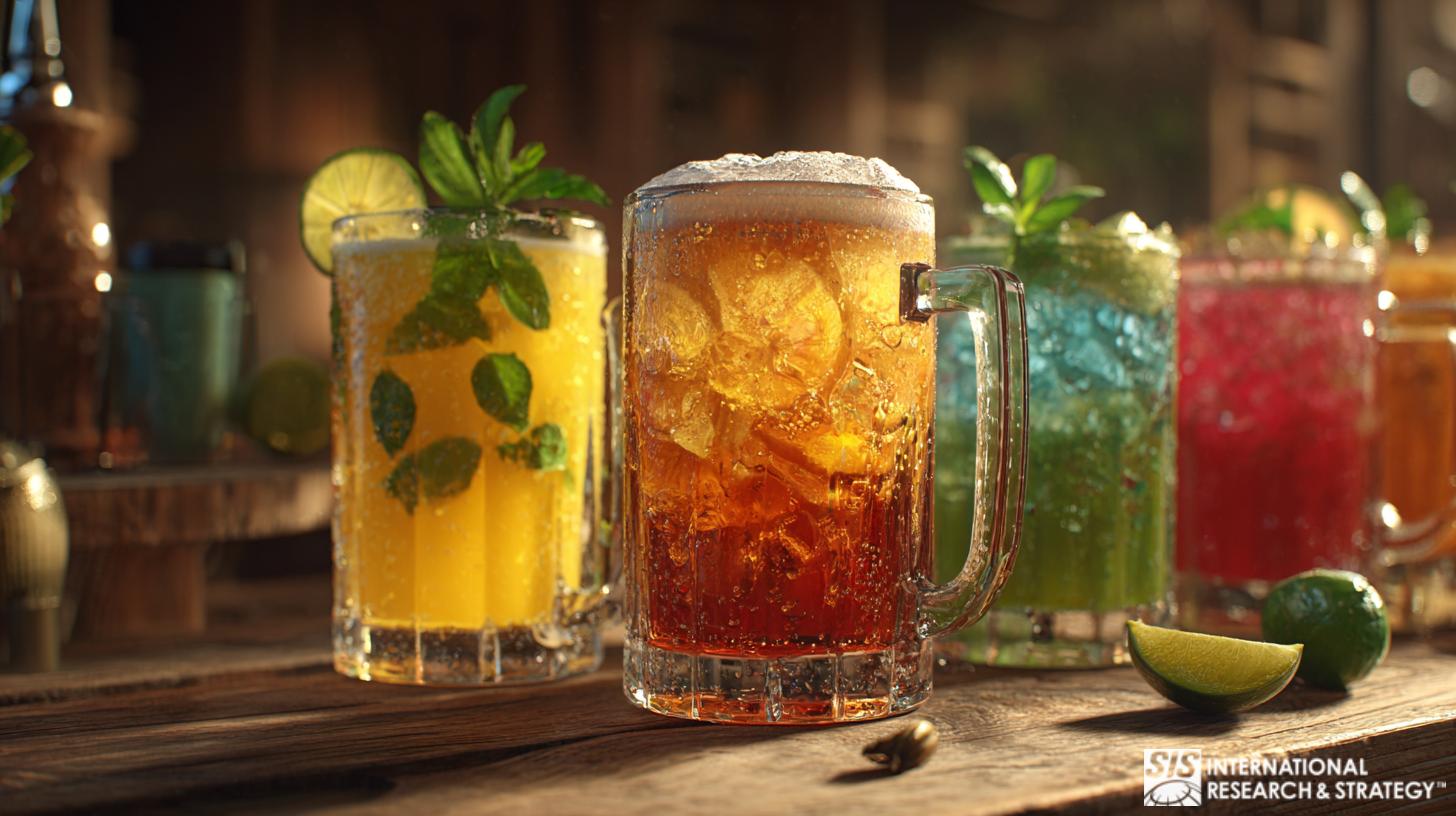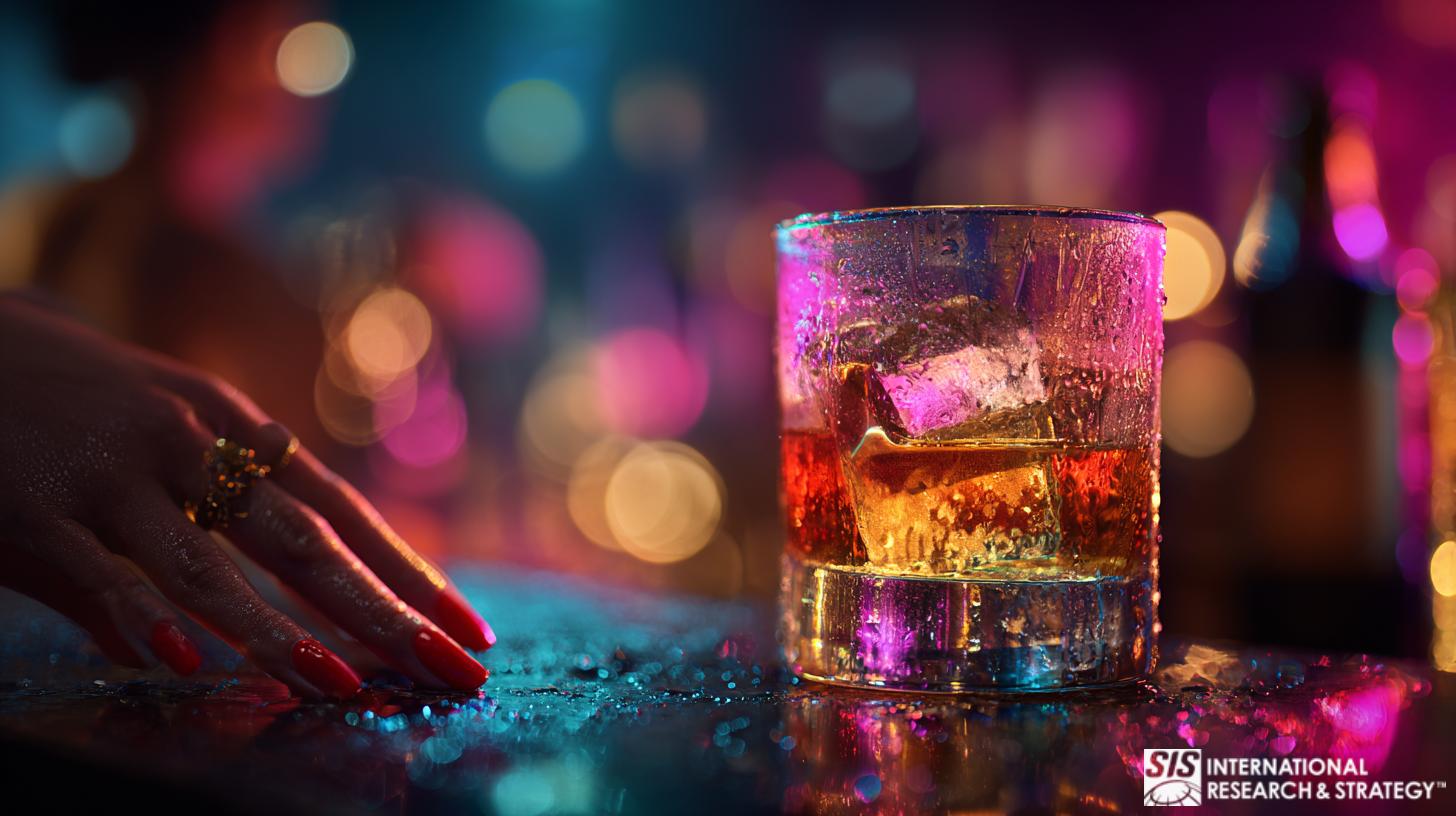酒精味覺測試

酒精味覺測試在飲料行業中起著至關重要的作用。它確保風味特徵的一致性,識別缺陷或異味,並指導開發滿足消費者偏好的新產品。
品牌如何確保其酒精飲料脫穎而出並始終滿足鑑賞家和休閒飲酒者的高期望?創造完美酒精飲料的工藝和科學是一門藝術,而酒精口味測試為市場成功奠定了基礎,確保每一口都能為消費者帶來發現和愉悅的旅程。
時間able of Contents
什麼是酒精味覺測試?
Alcohol taste testing is an in-depth analysis of the complex flavor profiles, aromas, and textures that define alcoholic beverages. It assesses the quality, character, and appeal of drinks, ranging from wines and spirits to beers and cocktails.
This taste testing evaluates the sensory characteristics of alcoholic beverages, including wine, beer, and spirits. It involves assessing appearance, aroma, taste, and mouthfeel to determine the beverage’s quality and characteristics.
During alcohol taste testing, trained professionals, known as “sensory panelists,” use their senses to identify and describe various beverage attributes, such as fruitiness, acidity, sweetness, and bitterness. These evaluations help producers understand consumer perceptions of their products and make informed decisions about product development and quality control.
為什麼企業需要酒精味覺測試?

Alcohol taste testing is essential for ensuring product quality and consistency. It allows producers to identify variations and make the necessary adjustments to ensure that every product reaching consumers maintains the brand’s quality standards. This consistency is critical to building and maintaining consumer trust and loyalty, as customers expect the same experience with every purchase.
此外,酒精口味測試有助於創新和差異化,因為生產商可以嘗試新的口味、混合物以及釀造或蒸餾技術,以創造出吸引市場興趣的創新產品。對於尋求引領而不是追隨市場趨勢的品牌來說,這種探索和完善的過程至關重要。
此外,酒精味道測試可以提供有關消費者偏好的寶貴見解,使品牌能夠客製化產品以滿足目標受眾不斷變化的口味。然而,它為企業帶來了許多其他好處,包括:
- 批次間的一致性: 酒精味道測試使品牌能夠密切監控變化並調整其方法,以確保消費者獲得一致的產品體驗。
- 市場差異化: 透過酒精口味測試,品牌可以探索創新的風味組合、生產技術和獨特的成分配置,使其產品與眾不同。
- 符合消費者偏好: 酒精味道測試可以深入了解目標市場的口味和偏好,使品牌能夠客製化產品以滿足這些期望。
- 增強的品牌敘事: 透過酒精口味測試發現的細微差別和品質可以豐富品牌的敘述,使其能夠講述一個關於其傳統、工藝和對品質的承諾的更引人注目的故事。
誰使用酒精味覺測試
這 生產烈酒、啤酒和其他酒精飲料的工匠 是酒精味覺測試的主要使用者。對於這些專業人士來說,該流程對於確保其產品的品質和一致性至關重要。 蒸餾器和啤酒廠 也利用口味測試來完善配方、調整發酵和蒸餾工藝,並確保每批產品都符合嚴格的風味、香氣和口感標準。
侍酒師與調酒師 rely on alcohol taste testing to deepen their understanding of different beverages and how they can be combined or presented to enhance the drinking experience. These professionals use their refined palates to curate selections for restaurants, bars, and events, ensuring each offering is high-quality and suits the intended audience or theme.
在較大的飲料公司中, 品質控制分析師 conduct alcohol taste testing during production to ensure every product meets the brand’s quality standards. These analysts look for any deviations in taste, aroma, or appearance that could indicate issues with the production process, helping to prevent subpar products from reaching the market.
Global Alcohol Industry Market Data & Consumer Taste Insights
| Market Segment | Current Value / Data | Projected Growth | Key Consumer Insights |
|---|---|---|---|
| GLOBAL MARKET SIZE & GROWTH | |||
| Total Alcoholic Beverages Market | $2,413.8B (2024) | $3,866.1B by 2032 CAGR: 6.04% |
Driven by premiumization trends and rising disposable incomes globally, particularly in emerging economies where middle-class growth accelerates demand. |
| Craft Spirits Market | $21.32B (2024) | $52.85B by 2033 CAGR: 10.61% |
Exceptional growth fueled by consumer demand for authenticity, artisanal production, and unique flavor profiles. Millennials and Gen Z driving innovation. |
| Distilled Spirits Segment | $82.01B (2024) | $226.82B by 2032 CAGR: 13.56% |
Fastest-growing segment with vodka dominating US consumption (77M 9-liter bottles annually), followed by rum, whiskey, and tequila. |
| REGIONAL MARKET LEADERSHIP | |||
| North America Market | $895.8B (38.4% share) | Leader in craft spirits US CAGR: 29.4% |
US consumers show strong preference for premium spirits and craft beers. Per capita alcohol consumption: 2.35 gallons annually, with diverse product preferences. |
| Europe Market | 45% global share | 10,000+ craft breweries operating | Strong tradition of alcohol consumption with 26% of global volume. Growing premiumization and craft beverage preference across all categories. |
| India Market (Emerging) | Rapid expansion phase | CAGR: 35.6% (craft spirits) | Fastest-growing market driven by rising disposable incomes, improving quality of life, and willingness to spend on premium beverages with local flavors. |
| CONSUMER TASTE PREFERENCES & SEGMENTS | |||
| Wine Consumer Preferences | Merlot: 23% Chardonnay: 19% Cabernet: 19% |
Premium wine tourism expanding | Wine drinkers seek authentic experiences. Pinot noir (17%), pinot grigio (16%), and rosé (15%) follow. Sustainability and organic production increasingly important. |
| Beer Consumer Segments | Light beer: 1.2B bottles Craft beer: 310M bottles |
Craft beer continuing growth | American consumers drank 1.2 billion cases in 2018. Taste testing reveals consumers prefer balanced mouthfeel, moderate alcohol warmth, and natural drinkability. |
| “Mild-Drink Lovers” Segment | 44% of consumers | Growing demographic | Predominantly women aged 18-29 with higher orosensory responsiveness. Prefer drinks with intense sweet taste and mixers that moderate ethanol perception. |
| Alcohol Consumption Rate | 62% of US adults (18+) | 20% reducing for health | One in five consumers has reduced alcohol consumption for healthier choices. Non-alcoholic alternatives projected to grow 70% as consumer priorities shift. |
| SENSORY ANALYSIS & TASTE TESTING INSIGHTS | |||
| Sensory Attributes Evaluated | 19-21 attributes standard | AI-driven analysis emerging | Professional panels assess appearance, aroma, taste, mouthfeel, aftertaste. Multiple evaluation periods (in-mouth, post-swallow, aftertaste) provide comprehensive profiles. |
| Consumer Taste Testing Methods | Paired preference tests Triangle tests Ranking tests |
30+ panelists minimum | Blind tasting protocols eliminate bias. Statistical analysis ensures reliable results. Consumers increasingly participate via smartphone-based home testing. |
| Key Flavor Drivers | Sweet, balanced, refreshing | Customization increasing | Low-frequency drinkers prioritize overall drinking comfort. High-frequency consumers focus on aroma subtleties. Alcohol warmth and persistence are mid-tier factors. |
| INNOVATION & PREMIUMIZATION TRENDS | |||
| Craft Distillery Growth | 21,745 US craft businesses | $32B annual sales | Craft beverages account for 8% of total US alcohol sales. Small-batch production, unique flavor infusions, and sustainable practices differentiate products. |
| Premium Product Preference | Leading market trend | All segments affected | Consumers willing to pay premium for high-quality, authentic experiences. Taste testing guides product development toward distinctive flavor profiles and artisanal character. |
| Cocktail Culture Impact | 60% of bartenders use local ingredients | Mixology driving innovation | Rise of upscale bars and restaurants accelerates demand for base spirits (gin, rum, whiskey). Consumers seek unique, curated experiences over mass-produced options. |
| ECONOMIC CONTRIBUTION & MARKET DYNAMICS | |||
| Federal Tax Revenue (US) | $11B (FY 2023) | 0.25% of total tax revenue | Distilled spirits contribute 60% of alcohol tax revenue, beer 30%, wine 10%. Industry supports extensive employment across production, distribution, and retail. |
| 分銷管道 | On-trade: 57.4% (2023) Off-trade: 42.6% |
E-commerce expanding rapidly | Restaurants, bars, and pubs lead sales but off-trade (supermarkets, wine shops) growing at 29.8% CAGR. Digital platforms enhancing accessibility. |
| 資料來源: Fortune Business Insights – Alcoholic Beverages Market | Straits Research – Craft Spirits Market | Grand View Research – Craft Spirits Analysis | Data Bridge Market Research – Global Spirits | Alcohol.org – Industry Statistics | Market.us – Alcoholic Beverages Report | PubMed – Consumer Preference Research | |||
何時進行酒精味覺測試
Identifying the optimal moments to conduct alcohol taste testing is crucial for maximizing its benefits across product development, marketing, and quality assurance. This strategic timing ensures that the insights gained from the testing process are both relevant and actionable – and here’s a breakdown of critical instances when alcohol taste testing is particularly vital:
- 產品發布前: 在推出新產品之前進行酒精口味測試至關重要。這種初步評估使品牌能夠根據專家和消費者的回饋來完善其產品,確保其滿足市場期望並有很大的成功機會。
- 產品開發期間: 酒精味覺測試在產品開發階段起著至關重要的作用。它使品牌能夠嘗試不同的配方、混合和陳化過程,以評估它們對最終產品風味特徵和整體感官體驗的影響。
- 生產或成分改變後: 每當生產過程或原料來源改變時,酒精味覺測試就變得必要。這些變化會顯著影響最終產品的味道和品質。儘管做出了這些改變,口味測試仍可確保產品仍符合品牌標準和消費者期望。
- 針對消費者的回饋: 如果一個品牌收到重要的消費者回饋或註意到消費者偏好的變化,那麼進行有針對性的酒精口味測試可能會有所幫助。這使得該品牌能夠探索新口味或對其產品進行調整,以更好地符合當前口味,確保其產品保持相關性並吸引受眾。
- 探索並適應市場趨勢: 在探索新的市場趨勢和適應消費者偏好的變化時,酒精風味測試至關重要。隨著飲料產業的發展,要保持領先地位(例如對低酒精或無酒精飲料的興趣日益增長),品牌需要不斷測試和改進其產品,以滿足不斷變化的消費者需求。
無論如何,企業管理者必須問自己以下問題:
- 目的: 口味測試的目標是什麼?是收集新產品的回饋、評估現有產品的品質還是其他?
- 樣本選擇: 樣本是如何選取的?它們會代表一系列口味、風格或品牌嗎?
- 品酒環境: 口味測試將在哪裡進行?環境是否有利於準確品嚐、沒有乾擾、沒有強烈的氣味?
- 品酒師選擇:誰會參加口味測試?他們會是訓練有素的專業人士、消費者,還是兩者兼具?
- 評價標準:將使用什麼標準來評估樣品?品嚐者會尋找特定的口味、香氣或特徵嗎?
- 回饋收集:如何收集和分析回饋?是否會匿名進行,是否會記錄下來以備日後參考?
酒精味覺測試中成長最快的領域是什麼?
- 工藝烈酒:包括威士忌、琴酒和蘭姆酒在內的精釀烈酒的受歡迎程度一直在上升,導致該細分市場對口味測試服務的需求不斷增加。
- 葡萄酒: The industry continues to grow, with consumers eager to explore different varieties and regions. This drives the need for taste testing to evaluate quality and characteristics.
- 非酒精替代品:非酒精飲料(包括無酒精烈酒和葡萄酒)市場正在不斷增長,為口味測試創造了機會,以開發吸引人的口味。
- 功能性飲料:功能性飲料,例如含有 CBD 或其他增強健康成分的飲料,越來越受歡迎。他們需要進行口味測試以確保消費者接受。
SIS International 酒精味覺測試的預期結果

當與 SIS International 進行酒精口味測試時,企業可以期待一系列重要的結果,這些結果可以增強其飲料的感官吸引力,並在競爭激烈的酒精市場上取得成功的戰略定位。以下是全面的酒精味道測試過程中可以預期的主要結果:
提高產品品質:
One of the primary outcomes is a tangible improvement in the beverage’s overall quality. This encompasses taste, aroma, and mouthfeel refinement, ensuring that the product meets and exceeds industry and consumer expectations.
符合消費者口味:
從味道測試中獲得的見解可以精確地符合消費者的喜好。這確保了產品符合當前趨勢和消費者需求,提高市場接受度和消費者滿意度。
策略市場定位:
酒精口味測試的詳細分析和回饋為市場定位和產品開發的策略決策提供了資訊。這使得品牌能夠更有效地瞄準特定的消費者群體並利用新興市場機會。
知情的產品開發:
The data-driven insights from taste testing guide the product development process, ensuring that new products are well received by the target market and are more likely to succeed upon launch.
持續改進的回饋循環:
酒精味道測試建立了一個有價值的回饋循環,能夠持續改進現有產品並指導未來產品的開發。這個迭代過程確保品牌能夠適應不斷變化的消費者偏好並保持競爭力。
Global Alcohol Market Growth Projections
Market value trends showing the expansion of total alcoholic beverages market alongside high-growth segments including craft spirits, distilled spirits, and premium wine categories through 2033.
Data demonstrates why taste testing and quality assurance are critical investments as markets expand and consumer expectations rise.
Key Growth Insights
- Total Market: Growing from $2.4T (2024) to $3.9T (2032) at 6.04% CAGR, driven by premiumization and emerging market demand
- Craft Spirits: Exceptional 10.61% CAGR reaching $52.9B by 2033, fueled by consumer demand for authenticity and unique flavors
- Distilled Spirits: Fastest-growing at 13.56% CAGR, expected to reach $226.8B by 2032 with vodka, whiskey, and tequila leading
- Quality Focus: As markets expand, taste testing becomes essential for maintaining consistency and meeting elevated consumer expectations
酒精味覺測試的優點和缺點
優點:
- 品質保證:酒精味道測試可確保產品符合預期的味道和品質標準。
- 消費者滿意度:味道測試可以透過確保產品滿足消費者的期望來提高消費者的滿意度和忠誠度。
- 產品改進:口味測試的回饋可用於改進產品,從而獲得更好的市場接受度。
缺點:
- 成本:進行味道測試可能會很昂貴,特別是在涉及許多樣品或聘請專業品嚐師的情況下。
- 主觀性:味道是主觀的,每個品嚐者可能有不同的喜好,導致結果不一致。
- 耗時:味道測試需要時間和資源來組織和進行,這對於日程緊張的企業來說可能是一個缺點。
Step-by-Step Process of Alcohol Taste Testing
本逐步指南概述了典型口味測試過程的關鍵階段,提供了專家如何評估和欣賞不同酒精飲料的見解。
- 樣品的選擇: Taste a variety of alcoholic beverages, including wines, beers, and spirits. Select samples that represent a range of flavors, styles, and brands.
- 樣品的製備: Ensure the samples are served at the correct temperature and in appropriate glassware to enhance the tasting experience. This includes using clean, odor-free glasses and serving the samples at the recommended temperature.
- 目視檢查: Inspect each sample visually. Note the beverage’s color, clarity, and viscosity. These visual cues can provide insights into the product’s age and quality.
- 香氣評估:旋轉玻璃杯以釋放香氣,然後聞飲料以識別各種氣味。注意香氣的強度和複雜性以及任何特定的香氣,例如水果、花香或香料。
- 口味評價: Take a small sip of each sample and allow it to coat your palate. Note the flavors present, including initial impressions and how they evolve. Consider the balance of flavors and the intensity of each component.
- 口感分析:考慮飲料在口中時的質地和口感。注意黏度、碳酸化程度(對於啤酒)以及酒精的光滑度、澀味或溫暖感等感覺。
- 整體印象:考慮每個樣本的平衡性、複雜性和完成長度,形成每個樣本的總體印象。評估口味的協調程度以及飲料是否令人愉悅和難忘。
- 討論與比較:與其他人(包括品酒師和專家)討論您的發現,以獲得不同的觀點和見解。比較每個樣本的註釋,以確定共同的主題和差異。
SIS 酒精味覺測試方法
SIS International 的酒精口味測試方法以其嚴謹的方法、深厚的專業知識和戰略洞察力而脫穎而出,所有這些都旨在為酒精品牌提供一條通往卓越的清晰途徑。這種多方面的方法確保了飲料的感官優勢並符合市場趨勢和消費者偏好。
專家主導的評估:
Expert-led evaluations are central to the SIS approach, where seasoned tasters with extensive experience in the alcohol industry conduct comprehensive assessments. These experts utilize a refined palate and deep knowledge of sensory analysis to discern and describe each beverage’s intricate flavors, aromas, and textures. This level of expertise ensures a thorough, nuanced understanding of the product’s sensory profile.
結構化感官分析:
SIS employs a structured sensory analysis framework that encompasses a range of attributes specific to alcoholic beverages. This includes but is not limited to appearance, aroma, body, taste, and finish. By adopting standardized evaluation protocols and using sensory lexicons, SIS ensures that analyses are detailed and consistent across sessions and products.
整合消費者洞察:
SIS 方法的獨特之處在於將消費者洞察融入酒精口味測試過程中。我們認識到飲料的最終成功取決於目標市場的接受程度,因此將感官評估與市場研究相結合。這種雙重方法使品牌能夠了解其產品如何與消費者產生共鳴,並找到與消費者品味和偏好保持一致的機會。
可行的建議:
Following the taste testing sessions, SIS provides brands with actionable recommendations based on the collected data. These recommendations are tailored to address each brand’s specific needs and objectives. The goal is to empower brands with the insights to make informed decisions that enhance their products’ appeal and market performance.
專注於持續改善:
SIS 方法的特點是注重持續改進。酒類市場充滿活力,消費者偏好不斷變化,趨勢不斷出現。 SIS 鼓勵品牌持續進行口味測試,以進行產品開發和品質保證。這種對持續改進的承諾確保品牌適應市場變化並保持競爭優勢。
機會
酒精口味測試為酒精產業的企業帶來了多種機會,使他們能夠改進產品、了解市場並為自己的成長和成功進行策略定位。以下是參與酒精口味測試所帶來的一些重要機會:
- 產品創新及多元化: Alcohol taste testing encourages innovation by allowing businesses to experiment with new flavors, ingredients, and production techniques. This experimentation can lead to the development of unique products that meet emerging consumer trends, such as craft spirits, non-traditional blends, or low-alcohol beverages, diversifying the brand’s product portfolio and appealing to a broader audience.
- 市場適應: 透過將消費者偏好和回饋納入口味測試過程,企業可以調整其產品以滿足目標市場的需求和願望。這種適應性在快速變化的行業中至關重要,可以幫助品牌保持相關性和競爭力。
- 品牌定位與故事敘述: Insights from alcohol taste testing can enrich a brand’s narrative, highlighting the craftsmanship, heritage, and quality that go into each product. This storytelling is a powerful marketing tool that can differentiate a brand in a crowded market, attracting consumers who value authenticity and quality.
- 競爭優勢: Alcohol taste testing gives businesses a competitive advantage by enabling them to offer products aligned with current market trends and consumer preferences. This strategic advantage can be key to gaining market share and establishing the brand as an industry leader.
SIS International 的酒精味覺測試如何幫助企業
SIS國際酒精味道測試方法透過嚴格的方法、深厚的行業專業知識和以客戶為中心的焦點脫穎而出。這種獨特的屬性組合確保企業獲得對其產品的全面感官評估以及能夠推動成長和創新的策略見解。
綜合感官分析:
SIS International employs a detailed and structured sensory analysis process that covers all aspects of the beverage experience, from appearance and aroma to taste and aftertaste. This thorough evaluation ensures every characteristic is noticed, providing businesses with a complete understanding of their product’s sensory profile.
專業知識與經驗:
這 安全資訊系統 International team of tasters brings together a wealth of experience and expertise across the alcohol industry. This depth of knowledge enables nuanced, sophisticated evaluations beyond basic taste preferences, offering insights into the subtleties that define premium-quality beverages.
整合消費者洞察:
A distinguishing feature of SIS International’s approach is the integration of consumer insights into its taste-testing process. By combining sensory analysis with market research, SIS International helps businesses understand how their products resonate with target audiences, enabling more informed decisions about product development and marketing strategies.
量身訂做的建議:
SIS International provides tailored recommendations specific to each business’s needs and goals. These actionable insights can address everything from product formulation adjustments to branding and market positioning, offering a roadmap to enhance product appeal and competitive advantage.
全球視野:
憑藉在各個市場的經驗以及對全球消費趨勢的深入了解,SIS International 為尋求國際競爭的品牌提供了至關重要的全球視角。這種全球視野確保口味測試考慮到可能影響不同地區產品成功的不同偏好和文化差異。

